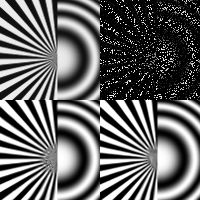
In this paper, we investigate the challenge of image restoration from severely incomplete data, encompassing compressive sensing image restoration and image inpainting. We propose a versatile implementation framework of plug-and-play ADMM image reconstruction, leveraging readily several available denoisers including model-based nonlocal denoisers and deep learning-based denoisers. We conduct a comprehensive comparative analysis against state-of-the-art methods, showcasing superior performance in both qualitative and quantitative aspects, including image quality and implementation complexity.

At public space such as a zoo and sports facilities, the presence of fence often annoys tourists and professional photographers. There is a demand for a post-processing tool to produce a non-occluded view from an image or video. This “de-fencing” task is divided into two stages: one is to detect fence regions and the other is to fill the missing part. For a decade or more, various methods have been proposed for video-based de-fencing. However, only a few single-image-based methods are proposed. In this paper, we mainly focus on single-image fence removal. Conventional approaches suffer from inaccurate and non-robust fence detection and inpainting due to less content information. To solve these problems, we combine novel methods based on a deep convolutional neural network (CNN) and classical domain knowledge in image processing. In the training process, we are required to obtain both fence images and corresponding non-fence ground truth images. Therefore, we synthesize natural fence image from real images. Moreover, spacial filtering processing (e.g. a Laplacian filter and a Gaussian filter) improves the performance of the CNN for detecting and inpainting. Our proposed method can automatically detect a fence and generate a clean image without any user input. Experimental results demonstrate that our method is effective for a broad range of fence images.

Latest trend in image sensor technology allowing submicron pixel size for high-end mobile devices comes at very high image resolutions and with irregularly sampled Quad Bayer color filter array (CFA). Sustaining image quality becomes a challenge for the image signal processor (ISP), namely for demosaicing. Inspired by the success of deep learning approach to standard Bayer demosaicing, we aim to investigate how artifacts-prone Quad Bayer array can benefit from it. We found that deeper networks are capable to improve image quality and reduce artifacts; however, deeper networks can be hardly deployed on mobile devices given very high image resolutions: 24MP, 36MP, 48MP. In this article, we propose an efficient end-to-end solution to bridge this gap—a duplex pyramid network (DPN). Deep hierarchical structure, residual learning, and linear feature map depth growth allow very large receptive field, yielding better details restoration and artifacts reduction, while staying computationally efficient. Experiments show that the proposed network outperforms state of the art for standard and Quad Bayer demosaicing. For the challenging Quad Bayer CFA, the proposed method reduces visual artifacts better than state-of-the-art deep networks including artifacts existing in conventional commercial solutions. While superior in image quality, it is 2–25 times faster than state-of-the-art deep neural networks and therefore feasible for deployment on mobile devices, paving the way for a new era of on-device deep ISPs.

Abstract In this article, a local structure adaptive total variation (LSATV) method for image restoration is presented. In our method, a discontinuity indicator is first proposed based on the eigenvalues of the structure tensor, which can effectively distinguish between edges and noises. Based on the proposed discontinuity indicator, a p norm is adaptively selected to match the local structure property of a pixel. Therefore, the proposed LSATV method inherits the advantages of both the Tikhonov regularization method and the total variation regularization method. Experimental results show the robustness of the proposed method and its superiority to state-of-the-art methods.